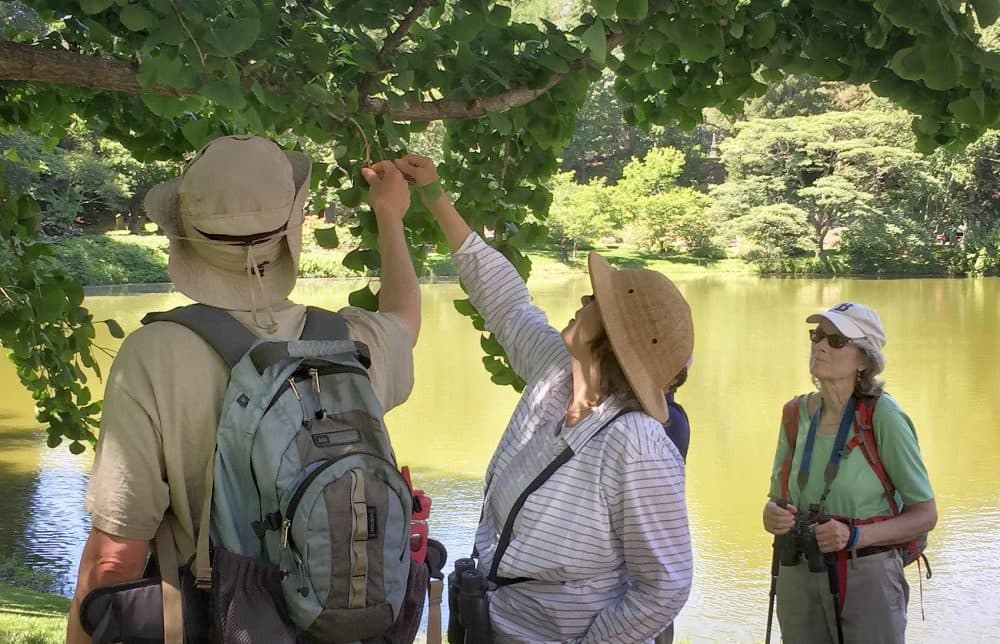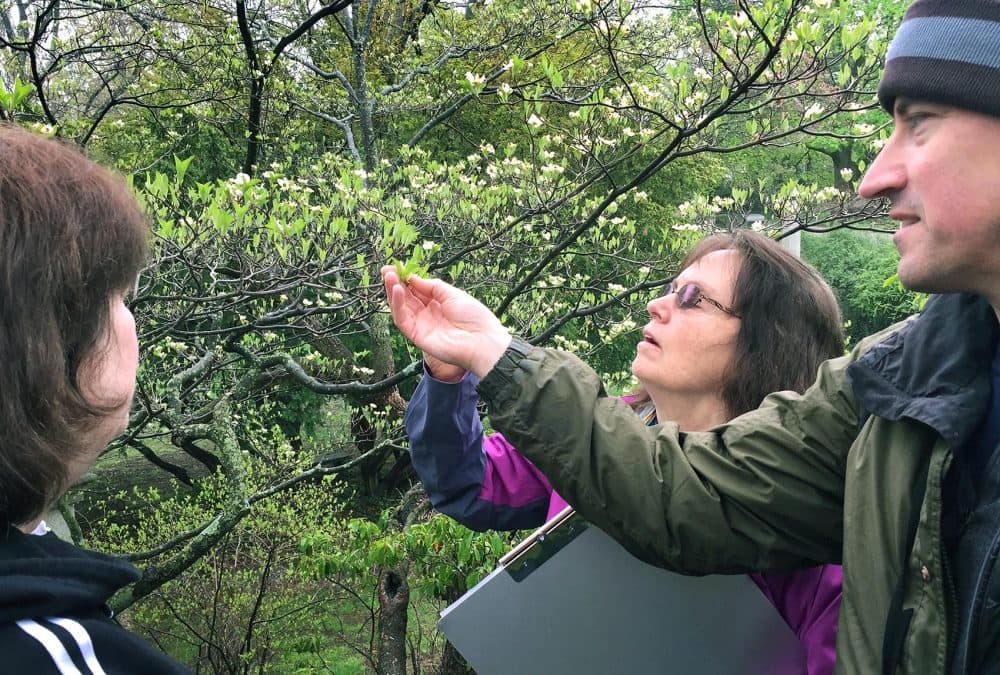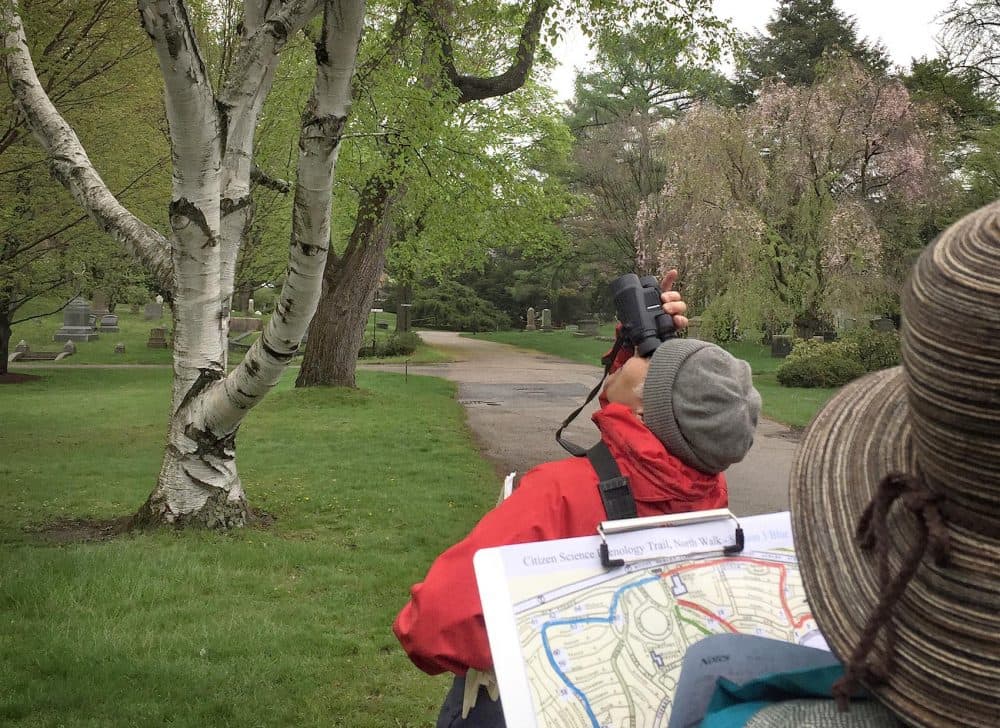Advertisement
CLIMATE CHANGE IN MASS.
Mount Auburn Cemetery Tree Trackers Gather Climate Data Amid Changing Beauty
Resume
Part of a series examining the effects of climate change here in Massachusetts
About 10 years ago, Liza Ketchum of Watertown noticed that the peonies in her garden were unfurling their big, showy blooms more than three weeks earlier than normal. And a rosebush that used to flower in the middle of June was now flowering in early May.
So how do these dramatic shifts in timing make her feel?
"Well, because of my family are scientists, I’m scared," she says.
Ketchum’s son and daughter-in-law study climate science and paint a daunting picture of what's to come. These days, Ketchum is becoming a climate scientist too: She’s what’s called a "citizen scientist" — part of a global network of people who gather and share data on climate change.
Her scientific territory is Mount Auburn Cemetery. The 175-acre cemetery in Cambridge and Watertown has long been renowned as the final resting place of Boston luminaries, and as an urban oasis of spectacular natural beauty — flowering trees, rolling hills, abundant bird life.
Now it's taking on a new role as a hot spot for tracking climate change.
On a recent, sunny June morning, Ketchum set out from the main cemetery gate with a half-dozen fellow volunteers and ecologist Brooks Matthewson on what’s called the "Phenology Trail."
Never heard the word "phenology"? Neither have most people. It refers to "the relationship between climate and observable annual biological phenomenon," Matthewson explains.
That includes the timing of when migratory birds arrive in the spring and depart in the fall. Or when the buds on the trees sprout new leaves and burst into bloom. Or when the leaves fall.

Those cycles are shifting here as the world warms. Boston University biology professor Richard Primack has worked on detailed climate change studies around Boston, including in Concord, where Henry David Thoreau described nature back in the mid-19th century.
"What we know is that plants are now flowering about two weeks earlier than they did in Thoreau's time, and trees are also leafing out about two weeks earlier," Primack says. "And we know that birds are arriving a couple of days earlier than in Thoreau's time."
Primack has used reports from Mount Auburn Cemetery's robust birder community in his research, and he says the quality of birder data tends to be high — they're experts at recognizing which bird is which.
In contrast, he says, when citizen scientists work with plants "we find there's a very high level of error, that people often can't identify the plants that they're looking at, they often get the species completely wrong."
But that's not happening with the Mount Auburn tree trackers, because the citizen scientists are trained and fill out their data sheets only at specially marked trees — dogwoods, sugar maples, ginkgos.
Advertisement

At "red oak number one," Matthewson explains the drill: "Just stand at the tree and see if we can see if the bud is bursting, if the leaves are emerging, the flowers are out," he says.
"And now, obviously, all the leaves have completely unfolded," Matthewson says as the volunteers note their findings on their data sheets.
The data is flowing in since the phenology trail program at Mount Auburn began last spring, Matthewson says. So far, more than 180 sheets have been filled out with 10,000 individual observations by two dozen volunteers.
It's careful work, with a learning curve. As Ketchum examined a dogwood, trying to tell if any of its flowers were becoming fruits already, she consulted with her volunteer colleagues to check her verdict that no, no fruit action yet.
And she sought Matthewson's expertise on a flower that seemed to be progressing beyond the bloom phase. No, he told her, for data sheet purposes, it was not yet a developed fruit.
"So what will this look like when it's a fruit?" she asks.
"It will be a red seed," he explains, bright red and berry-like, containing a stone in which the seed is found.
Primack, the BU professor, says global warming will likely change Mount Auburn Cemetery's trees: They'll probably be infested by more insect pests. Species that need cold, like sugar maples, may not thrive, while warmer-weather magnolias may.
"The beauty in the spring, the kind of tremendous display of flowers, will happen earlier than in the past," he says.
The cemetery will remain beautiful, he says, but that beauty will change.
As it does, the citizen scientists of Mount Auburn Cemetery will be watching — and keeping track.
This segment aired on June 28, 2017.
